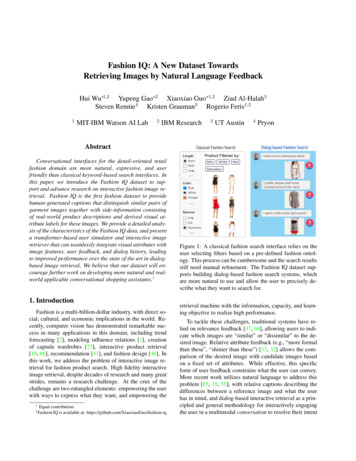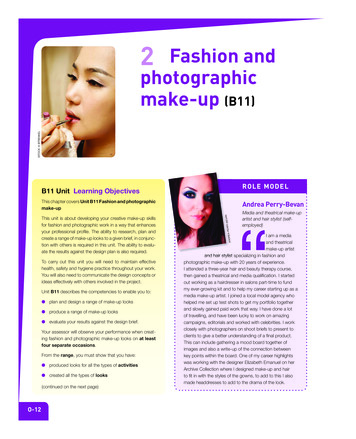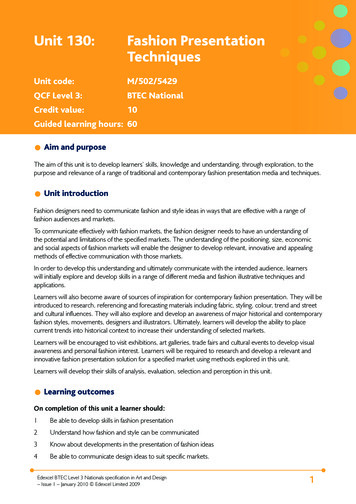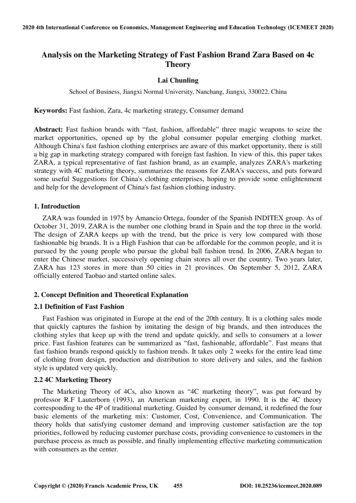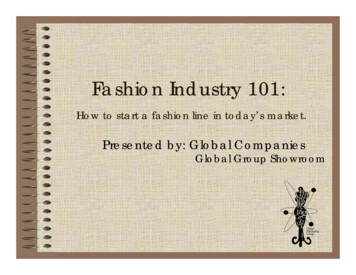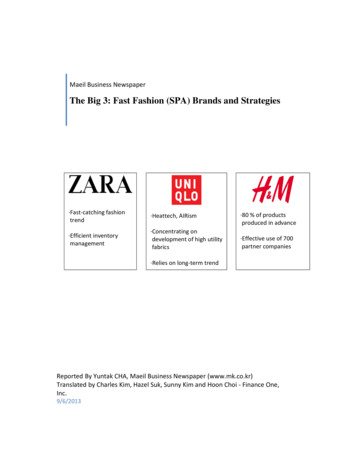
Transcription
Maeil Business NewspaperThe Big 3: Fast Fashion (SPA) Brands and Strategies·Fast-catching fashiontrend·Heattech, AIRism·80 % of productsproduced in advance·Efficient inventorymanagement·Concentrating ondevelopment of high utilityfabrics·Effective use of 700partner companies·Relies on long-term trendReported By Yuntak CHA, Maeil Business Newspaper (www.mk.co.kr)Translated by Charles Kim, Hazel Suk, Sunny Kim and Hoon Choi - Finance One,Inc.9/6/2013
Comparative table of 3 major global SPA brandsBrandZARAMother CompanyInditexHome Country(Founding Year)SalesSpain (1975)StoresTrend AnalysisSCM – SupplyChain ManagementStore ManagementUNIQLOH&MFast Retailing Apparel H&M Hennes &Co.Mauritz ABJapan (1984)Sweden (1947) 21.6 B(as of 1/31/13)6,009 stores aroundthe world –Inclusiveother brands such asBershka, Pull&Bear,Stradivarius, MassimoDutti and Oysho*80% of its designersinvolved in designercollection*20% involved instreet & celebritiesfashion*Secure fabrics inadvance*14 company-ownedfactories 9.1 B(as of 8/31/12)2,222 stores aroundthe world – Inclusiveother brands such asGU, Theory,Princesse Tam.Tam 18.8 B(as of 11/30/12)2,800 stores aroundthe world*Focus on materialdevelopment insteadof fashion trends*Utilize globalfashion trendforecaster such asWGSN*Secure fabrics inadvance*No company-ownedfactories*Unified VMD*Headquarterdistributes VMDmanual twice a month*Grant priority overfranchise license towell-performed storemanager*No company-ownedfactories*Partner companiessecure fabric andproduce*Locally customizedVMD*Wait until availablefor the best storelocation**Sources: Sales and number of stores are based on annual report of each company, and Business Week.VMD: Visual Merchandising DisplayIntroductionIt is the heyday of fast fashion (SPA: Specialty retailer of Private label Apparel). Pastclothing companies forecast fashion trend by sending their designers to fashion shows twice ayear, and they spent 9 months to a year to design and produce clothing for the following year. Incontrast, SPA brands are introducing clothing items that embody the latest trends at affordableprices on a weekly basis. The three leading global SPA brands are Zara, Uniqlo, and H&M (Big3). Although the Big 3 companies are constantly competing with one another in sales, brandrecognition, and market share, each employs distinct and unique strategies. Despite thedifferences in each company’s approach to providing the trendiest clothing to consumers, fashion
trend analysis, supply chain management (SCM), and store operations are at the core of the Big3’s strategies. This report analyzes and compares the core strategies utilized by the Big 3.ZARAZara of Spain best fits the general definition of SPA. Zara has over 1,900 storesworldwide (6,009 stores if Pull & Bear, Bershka and other brands are included) and introducesminimum two newly-designed items per week – 10,000 new items in a year. Only 15–20% ofZara’s total production is pre-made while 80-85% is produced according to the market reaction.This is perhaps the reason why Zara is the most responsive to fashion trend among theBig 3. Due to high inventory turnover ratio, consumers may not find on Zara floors the items thatthey have seen in the previous week. Of course, Zara undoubtedly uses this tactic as a marketingtool to attract consumers.Zara employs 80 designers, of which 80% concentrate on runway designer collectionsand 20% on analyzing up-to-the-minute street and celebrity fashions. In addition, productmanagers and store managers share consumers’ responses every week. It takes Zara merely threeweeks to pick out a trend and move onto production.To minimize cost, Zara secures fabric in advance while delaying the finalized design aslong as possible. Then, the prepared fabrics are processed in its own 14 cutting-edge facilities inSpain. By owning its production factories, Zara has eliminated the need to rely on othercompanies while keeping the production process flexible. Next, the finishing touches are made inover 300 facilities in countries such as Portugal.The last factor which contributes to Zara’s success is its store presentation. Each store isidentical to the others regardless of location. This uniformity is achieved through distribution ofinstruction manuals every two weeks and strict enforcement of the Visual MerchandisingDisplay (VMD) in each store.UNIQLOJapan’s Uniqlo deploys a completely different strategy from Zara. Some argue thatUniqlo is not an SPA brand because of its commitment to developing long-lasting clothing items.Uniqlo is not sensitive to trends in fashion. Instead, it puts much efforts in establishing timeenduring trends. Rather than working on short term fashion trends, Uniqlo’s strategy revolvesaround developing unique fabrics which last for a long time. “Airism” in summer and “Heattech”in winter seasons best represent Uniqlo’s philosophy of ingenuity and originality. Contrast to
Zara’s lavish one-piece dresses, Uniqlo produces jeans, under garments, jackets, and children’sclothes that are casual but are of high quality.Uniqlo’s designers work as project teams to develop new fabrics before studying fashiontrends. Once the laboratory develops a new fabric, designers in Tokyo, New York, Paris, andMilano begin to make designs that fit the new fabric. The time it takes from development offabric to product distribution is inevitably longer than competing SPA companies. Producinglarge quantities of a handful, selected items is definitely an advantage, however, because of costreduction.Uniqlo secures its fabric in advance by developing new materials in cooperation withpartnering companies. Since Uniqlo does not operate its own production factories, 90% of itsoverall production comes from China.For store locations, Uniqlo actively searches for areas with high potentials. By awardinghigh-achieving store managers with priority right in opening new franchise stores, Uniqlosuccessfully retains its employees.H&MH&M of Sweden uses strategies which are a mixture of Zara’s and Uniqlo’s methods.H&M produces 80% of its clothes in advance and introduces remaining 20% based on the mostcurrent market trend. H&M offers trendy clothes similar to Zara’s, but it also offers diversifieditems on children and accessories like Uniqlo. Hence, H&M is considered a hybrid of Zara andUniqlo.H&M tends to rely on outsourcing from design to production. Although H&M’s coreoperation relies on its designers, creative directors, and pattern makers to stay on top of the latesttrends, it also uses the services of fashion trend forecast companies such as Worth Global StylesNetwork (WGSN).The most prominent characteristic of H&M is its ability to operate efficiently withpartner companies. H&M utilizes over 700 partner companies in over 20 different countries as ifthey are its own. Thirty production oversight offices of H&M are also strategically located foreasy contact with the partner companies. H&M shares its information with the partner companieson the latest fashion trends and the internal matters of the company. Unlike Zara, H&M does notown factories and does not strive to secure fabrics in advance. Instead, its partners secure fabricson behalf of H&M. With this method of operation, H&M simply has to place an order with oneof the partner companies which already have the necessary fabrics. Once H&M finds a desiredlocation for a new store operation, the company waits until the space is available. Similar to
Zara, H&M features uniform stores worldwide. Some stores, however, feature elements andcomponents that are specifically tailored to that region.ConclusionThe global Big 3 SPA brands are growing fast by developing their own unique strategiesto build competitive advantage over the others. Young Joon Cho of L.E.K, a global consultingcompany, says, “Each of the Big 3 SPA brands has achieved success through its own growthprocess, market positioning, and brand concept. Aspiring SPA brands should go beyondimproving their efficiency in distribution and must work on differentiating themselves fromcompetitors just as the Big 3 have done.”Link: http://news.mk.co.kr/newsRead.php?year 2013&no 815741
Reported By Yuntak CHA, Maeil Business Newspaper (www.mk.co.kr) Translated by Charles Kim, Hazel Suk, Sunny Kim and Hoon Choi - Finance One, Inc. 9/6/2013 . SPA brands are introducing clothing items that embody the latest trends at affordable prices on a weekly basis. The three leading global SPA brands are Zara, Uniqlo, and H&M (Big .
